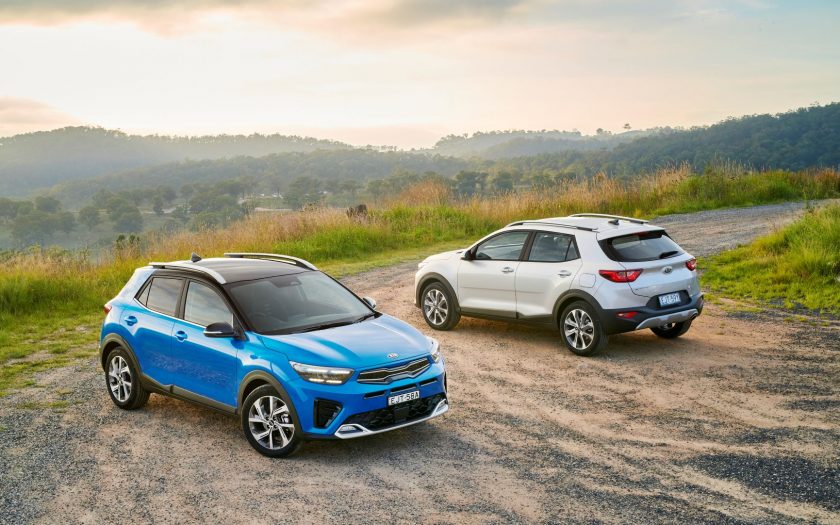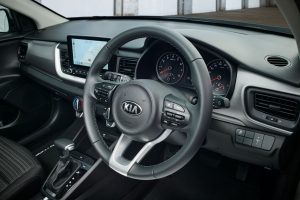Chris Riley tests the 2023 Kia Stonic S with pricing, specs, ride and handling, safety, verdict and everything the over-50 driver needs to know.
Summary: The Kia Stonic S undercuts its most obvious competitors, and like all Kias, offers great value for money, an acceptable trim level and that all-important seven-year warranty.
2023 Kia Stonic S light SUV
Pricing: $23,790 (plus on road costs)
Options: premium paint (any other than white) $520
Warranty: Seven-years/unlimited km, one-year roadside assist
Safety: 5-star ANCAP (tested 2017)
Build location: South Korea
Engine: 1.4-litre 4-cylinder DOHC petrol
Power: 74kW at 6000rpm
Torque: 133Nm at 4000rpm
Transmission: 6-speed sports automatic, front-wheel drive
Body: 4140mm (long); 1760mm (wide); 1500mm (high)
Weight: 1183kg
Towing capacity: 1000kg
Wheels: 15-inch alloy
Tyres: 185/65 R15
Ground clearance: 165mm
Fuel tank capacity: 45 litres
Official consumption: 6.7L/100km (91 RON petrol)
Consumption on test: 6.9L/100 (400+km)
seniordriver consumption on test: 6.5L/100km (504km)
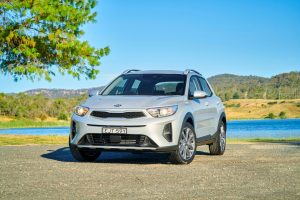
[review]
Based on the same platform as the Rio hatch, Stonic is the smallest of Kia’s SUVs.
Designed by the maestro Peter Schreyer, the name is a combination of the words “stylish” and “iconic”.
In Australia, Stonic is available with 1.4-litre four cylinder or turbocharged 1.0-litre three-cylinder petrol engines, the latter confined to the top of the range GT-Line.
Top seller in this section of the market is the Mazda CX-3, followed by the Toyota Yaris Cross, with the Hyundai venue in third place. Nipping at their heels is the Kia Stonic.

What’s it cost?
Stonic is not just small, but categorised as a light SUV.
Nuggety, with a bulldog-like stance, it has seating for five, at a pinch.
The car presents as more than the sum of its cheap and cheerful parts.
But it’s dragged down by the nasty, plastic hubcaps that need the old heave-ho.
Enhancing the look are stylish roof rails, a spoiler over the rear window, front and rear bumper inserts, along with protective cladding for the lower-body and wheel arches.
Bumpers, door handles and mirrors are all body coloured.
Inside, it’s all familiar and practical, with analogue instrument dials, small 4.2-inch driver information display and central 8.0-inch touchscreen.
There are two cupholders in the centre console and bottle holders for each of the doors.
Our test vehicle, the entry S model, comes with cloth trim and manual air conditioning, priced from $22,290 (plus on road costs) for the S manual, and another $1500 for an auto.
Every colour except Clear White is a premium option and adds $520 to the price.
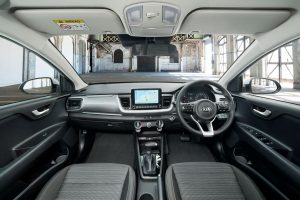
Standard kit includes cruise control, auto lights (not wipers), roof rails, power windows front and back, reverse parking sensors and 15-inch steel wheels with the aforementioned hubcaps (remember them).
The driver’s seat is height adjustable and the steering wheel has both reach and height adjustment.
Infotainment consists of an 8.0-inch touchscreen, Bluetooth with audio streaming and support for two phones simultaneously, wireless Apple Carplay and wireless and wired Android Auto and six-speaker sound.
All models have USB ports for the connection of memory sticks and other USB storage devices for both front and rear passengers.
There’s also one USB port and one 12-volt outlet in the centre console.
The S misses out on navigation as well as DAB+ digital radio.
Stonic scores a full five-star safety rating, with six airbags, a rear-view camera with dynamic guidelines and autonomous emergency braking (AEB) that includes car, pedestrian and cyclist detection. It is active from 5km/h to 180km/h for vehicles and 5km/h to 85km/h for pedestrians and cyclists.
Cornering brake control (CBC) assists with control and balance when braking on curves, while driver attention alert (DAA) recognises signs of fatigue before recommending the driver takes a break.
The safety package also includes lead vehicle departure alert with lane keeping assist (LKA) which alerts the driver and activates steering control if the vehicle drifts out of its lane without the use of an indicator.
Lane following assist (LFA) identifies current lane and lane boundaries and will automatically centre the car if unintentional lane departure is detected.
Rear occupant alert (ROA) is a class leading inclusion that monitors rear door opening and closing, alerting the driver when rear seat passengers exit the vehicle.
What you don’t get, and what none of the grades get, is blind spot alert.
Once offered, auto high-beam seems to have disappeared from the range.
There are three child restraint anchor points as well as two ISOfix mounts.

What’s it go like?
Stonic sits 4140mm long, 1760mm wide and stands 1520mm high with roof rails.
It has a wheelbase of 2580mm and minimum ground clearance of 165mm in S form.
Rear legroom is limited, with belts for three but room for only two adults realistically – and no air vents.
There’s 332 litres of boot space with the seats in place or 1155 litres with them folded.
A space saver spare wheel is located under the boot floor.
The 1.4-litre four-cylinder petrol engine in the S produces 74kW of power at 6000 rpm and 133Nm of torque at 4000 rpm.
Drive to the front wheels through either six-speed manual or six-speed automatic transmissions.
In comparison, the 1.0-litre three-cylinder turbo delivers 74kW at 4500 rpm and 172Nm from 1500 to 4000 rpm, and is paired with a 7-speed dual clutch style auto.
As mentioned, Stonic shares a platform with the Rio hatch, making it the SUV version of the Rio.
Subtle differences include the gearbox which has been pushed forward 28mm, an increased caster angle from 4.1 degrees to 4.6 degrees and high-performance RS-valve shock absorbers.
At the rear, the use of a more vertical setup for the shocks (8.4 degrees off vertical as opposed to Rio’s 25 degrees) and enhanced torsion beam construction has brought further improvement in ride quality and NVH.
To complete the engineering changes, the number of teeth on the motor driven power steering has been increased, resulting in more refined and precise steering input and feel.
Suspension is Macpherson strut at front and torsion beam at the back and it rides on Kumho tyres with a 185/65 profile.
For 1.4 models, Kia says the handling targets were neutral balance with good overall grip and stability.
The steering is designed for precise on-centre feel and accuracy with mid-corner composure at high speed.
The six-speed auto in our test vehicle was a welcome surprise.
We were kind of expecting an old style four-speed at this price point.
The difference is chalk and cheese.
The 1.4 doesn’t labour, doesn’t hunt for gears on hills and generally delivers pretty respectable, if unexciting, performance across the board.
Cruise control is another surprise at this price.
But a hard-on-the-hands polyurethane steering wheel never lets you forget where you are.
Using the transmission lever, you can change gears manually with the auto, but no drive modes are offered to lift performance.
Punting hard in manual mode was something of a revelation.
Ride and handling are excellent, with a caveat that the ride is somewhat compromised by the Kumho Ecowing tyres fitted.
Anything with ‘eco’ in the name generally means a harder tyre compound to produce lower fuel consumption (at the expense of ride quality).
The steering is very good too, not too light and locks down on-centre without constant need for adjustment.
Navigation and digital radio are missing in action, but you can connect your phone to navigate.
In fact, you can connect it wirelessly with both CarPlay and Android Auto, but wireless charging is really required or you’ll soon find your phone runs out of battery if it is a long trip.
Disconnection in the CBD is always a problem too, precisely at the wrong moment.
Fuel consumption for the 1.4 is 6.0L/100km (manual) and 6.7L/100km for the auto, with the turbo good for 5.4L/100km.
CO2 emissions range from 155g/km for the six-speed automatic down to 125g/km for the turbo.
With a 45-litre tank, it takes regular unleaded.
We were getting 6.9L/100km after more than 400km – but for a car this size it could be better.
What we like
- Cheap
- Cheerful
- Easy to drive
What we don’t like
- Hubcaps
- Key to start
- Wireless CarPlay/Android Auto requires wireless charging
What over-50 drivers need to know
Kia Stonic has retirement written all over it.
It’s small, practical, doesn’t use much fuel and, importantly, doesn’t cost much.
With five-star safety and the practicality of an SUV, Stonic is also an ideal city car or perhaps starter car for a teenager.
It’s cheap and cheerful, cruise control at this level is a real bonus and you really can’t go past that 7-year warranty.
It’s cheaper than a CX-3 or Yaris Cross too.
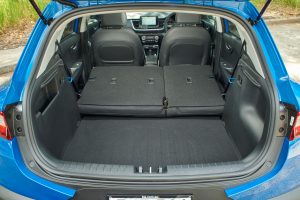
seniordriver comments
The next generation Kia Rio will not be built in right-hand drive, so when current supplies run out (500 are on back order in Australia) that will be the last we see of the Rio. Dealers have been advised to stop taking orders for it and ensure all existing orders can be filled before production ends.
The light hatch category has been severely depleted by the withdrawal of the Suzuki Baleno, Mitsubishi Mirage, and now the Kia Rio, meaning the sub-$20,000 car in Australia is effectively extinct.
And that explains why seniordriveraus reader Joan decided to replace her 10-year-old Rio with a new Stonic.
She chose the base model S, as tested here, with auto, and with premium paint, she’s looking at mid-$20’s when she drives it off the showroom floor.
The major players in the class are the Mazda CX-3 (from $25,510 plus on road costs), the Toyota Yaris Cross (from $29,840 plus on road costs) and the Hyundai Venue (from $26,250 plus on road costs). That means all will be very close to or exceed the $30,000 price barrier once the usual costs are factored in.
Pity the poor car buyer!
The Stonic misses out on a few features that most people would have on their wish list, but at this price point, some penny-pinching here and there is inevitable, although we consider the absence of blind spot monitoring to be a serious oversight. Having said that, we’re pleased to see the autonomous emergency braking, including pedestrian and cyclist detection, is included. Well done, Kia! And despite Chris’ comments about plastic wheel covers, we couldn’t find any images to support that, so we’ve asked Kia to clarify.
Not so positive is the 5-star ANCAP rating issued in 2017, meaning it will soon expire. At this stage of its model life, we doubt whether the Stonic will be retested (we’ve asked Kia to clarify).
Power of 74kW and torque of 133NM sounds fairly meagre, but the Stonic always feels more robust and muscular than those figures would suggest, and this impression is enhanced by the six-speed auto.
We had a few issues with the Stonic we tested. The cruise control tries to hold the speed to the set limit, but it doesn’t always succeed. That could be an expensive failure! Perhaps that explains why the speedo was so optimistic – an indicated 100km/h was actually 93, and while most speedos over-read, most aren’t as far out as this one.
About the only other car we’d suggest investigating before making a final decision would be the MG ZS which officially sits in the Light SUV category. It makes do with a four-speed auto, is slightly larger overall and a bit thirstier. But from $23,990 driveaway, it has to be worth a look.
Like all Kias, the Stonic delivers good value, high build quality and a high level of practicality. Little wonder Kia is climbing up the sales charts.
